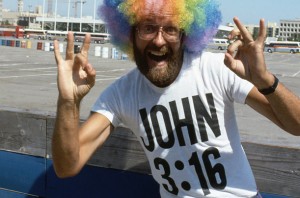From John’s Gospel:
Just as Moses lifted up the serpent in the wilderness, so must the Son of Man be lifted up, 15that whoever believes in him may have eternal life. For God so loved the world that he gave his only Son, so that everyone who believes in him may not perish but may have eternal life.
(From the Daily Office Lectionary – John 3:15-16 – August 13, 2012)
 A very familiar quotation from Scripture that second verse: anyone who has ever attended a sporting event in the United States (or watched one on television) as seen someone holding up a sign with “John 3:16” emblazoned on it. Often that person is wearing a rainbow-colored “Afro” wig. Anytime I have witnessed that spectical I’ve wondered, “Has anyone ever become a follower of Jesus because of that sign?” I’m pretty certain the answer is “No.”
A very familiar quotation from Scripture that second verse: anyone who has ever attended a sporting event in the United States (or watched one on television) as seen someone holding up a sign with “John 3:16” emblazoned on it. Often that person is wearing a rainbow-colored “Afro” wig. Anytime I have witnessed that spectical I’ve wondered, “Has anyone ever become a follower of Jesus because of that sign?” I’m pretty certain the answer is “No.”
I’m also pretty certain that Jesus didn’t utter the words attributed to him in verse 16. I’m not alone in believing that, by the way. There are a lot of scholars who think that John’s quotation from Jesus ends with verse 15 and everything that follows is John’s commentary on what Jesus said, not the words of Jesus himself. That’s not the way most bible translations show it, however. In any event, whether the words of verse 16 are Jesus’ or John’s, another thing I’m pretty certain of is that they have nothing to do with getting into heaven!
That’s how most people understand this, I think, but I believe their understanding to be dead wrong. I use that term advisedly because the question really is about whether these words apply to what happens before we die or after we die. Believing in Jesus isn’t supposed to be some sort of eternal life insurance policy, a ticket to heaven, a pass into the new Jerusalem and all its loveliness as portrayed by another John in the Book of Revelation; it’s supposed to be about how we live in the present.
Believing in Jesus and gaining eternal life is supposed to be a present reality. “Eternal life” is John’s way of naming what the Synoptic Gospel writers called “the kingdom” (the kingdom of God or the kingdom of heaven, same thing). It’s the here-and-now transformed by our belief and not simply by our belief but by our action. We who believe in Jesus do not perish but have eternal life, life in the kingdom, because our belief compels us to work with God to create that life in the world in which we live. As another part of the Johannine literature puts it, “We know love by this, that he laid down his life for us — and we ought to lay down our lives for one another. How does God’s love abide in anyone who has the world’s goods and sees a brother or sister in need and yet refuses help? Little children, let us love, not in word or speech, but in truth and action.” (1 John 3:16-18)
In my faith tradition (the Episcopal Church) a public statement of faith at baptism is always followed by a public commitment to action. The candidate (indeed, the whole congregation) is asked if he or she believes in God the Father, God the Son, and God the Holy Spirit; the answers to these questions are simply the words of the Apostle’s Creed. The candidate and congregation are then asked to commit themselves to five consequent actions: to continue in the apostles’ teaching and fellowship, in the breaking of bread, and in the prayers; to persevere in resisting evil, and, whenever they fall into sin, to repent and return to the Lord; to proclaim by word and example the Good News of God in Christ; to seek and serve Christ in all persons, loving their neighbors as themselves; and to strive for justice and peace among all people, and respect the dignity of every human being. When asked if they will do each of these things, the candidate and the congregation respond, “I will, with God’s help.”
These are the consequences of belief in God in Jesus Christ. These are the consequent actions through which, in partnership with God, we bring the kingdom on earth as it is in heaven. These are the consequent actions through which, with God’s help, we live eternal life.
====================
Father Funston is the rector of St. Paul’s Episcopal Church, Medina, Ohio.



Leave a Reply